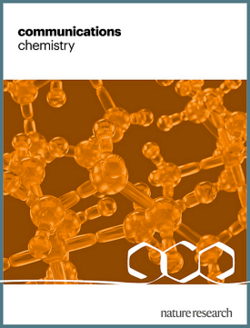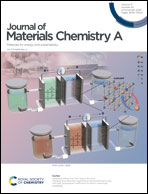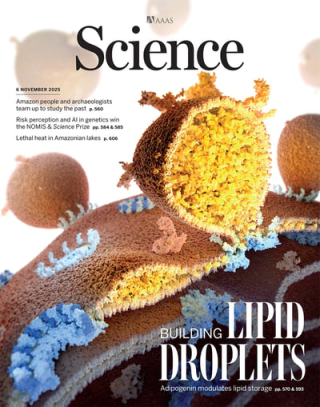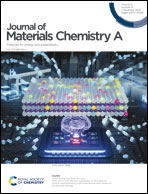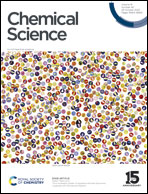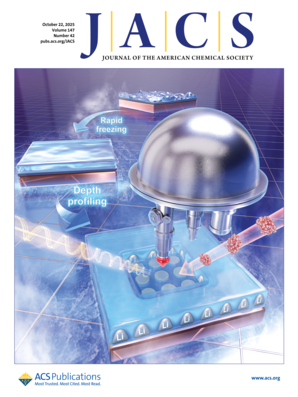-
5 Nov 2025 • Journal Article • Communications Chemistry
Catalytic ester hydroboration promoted by actinide complexes featuring six-membered N-heterocyclic imine ligands and actinide-alkoxides activation
AbstractIn the last decade, organoactinide complexes have been active catalysts for the hydroboration of carbonyl moieties, including aldehydes, ketones, amides, isocyanides, and carbonates. The decoration of the metal center by 5, 6, or 7-N-heterocyclic imines increases the electron density at the metal, allowing for remarkable catalytic performances. We report herein the
… show more -
4 Nov 2025 • Journal Article • Journal of Materials Chemistry A
Phosphorylated carbon cathodes achieve perfect monovalent cation selectivity in capacitive deionization
AbstractSelective sodium removal from water sources is crucial for irrigation and other applications, yet challenging due to the abundance of sodium ions compared to essential minerals like calcium and magnesium. Capacitive deionization (CDI) is an emerging electrochemical technique for water treatment and desalination which uses a small electrical potential to adsorb ions in
… show more -
30 Oct 2025 • Journal Article • Science
Porous materials: The next frontier in energy technologies
AbstractPorous materials with pore sizes spanning the range from molecular to macroscopic dimensions (from angstroms to centimeters) are essential in electrochemical, thermoelectric, nuclear, and solar power sources and in the extraction of oil, gas, and geothermal heat. To enable the clean, fast, and efficient conversion of energy, the porous structure must be designed to
… show more -
28 Oct 2025 • Journal Article • Journal of the American Chemical Society
Vicinal Stereocenter Construction via α-Boryl Carbanions from Borylated Cyclopropanes
AbstractWe report generation and stereocontrolled electrophilic trapping of α-boryl carbanions via the selective anionic ring-opening of stereodefined iodomethyl cyclopropylboronic esters. The strategy relies on a lithium–iodine exchange to generate borata alkene intermediates, affording vicinal tri- and tetrasubstituted boronic esters with excellent levels of diastereoselectivity
… show more -
21 Oct 2025 • Journal Article • Journal of Materials Chemistry A
Does the presence of CO2 affect the alkaline stability of anion-exchange membranes?
AbstractAnion-exchange membranes (AEMs) enable electrochemical energy devices to operate in alkaline environments, allowing the use of earth-abundant, platinum group metal-free catalysts. This makes them highly attractive for applications such as AEM fuel cells (AEMFCs), water electrolyzers (AEMWEs), and oxygen separators (AEMOSs). However, two key challenges still hinder their
… show more -
15 Oct 2025 • Journal Article • Chemical Science
SpyTag/SpyCatcher-mediated protein ubiquitination to investigate 20S and 26S proteasomal degradation
AbstractUbiquitination significantly influences human health and disease because it plays an essential role in many cellular signaling pathways. To investigate the effects of different types of ubiquitination, various strategies based on synthesis, semisynthesis, or expression have been developed for protein ubiquitination. Here, we introduce a new method for protein ubiquitination
… show more -
14 Oct 2025 • Journal Article • Physical Review Letters
Spontaneous Emission from Electronic Metastable Resonance States
AbstractWe demonstrate that calculating the spontaneous emission decay rate from metastable resonance states (states with finite lifetimes embedded in the continuum) requires considering transitions to all continuum states, not just to lower states. This holds even when the lifetimes of the metastable states are very long and might be effectively considered as bound states in
… show more -
8 Oct 2025 • Journal Article • Journal of the American Chemical Society
Calochorturils: Chiral Bowl-Shaped Cavitands Obtained by Anisotropic Tangential Substitution
AbstractSubstitution of the extended tribenzo-cyclononatriene transforms an achiral cavitand into a chiral host molecule. Calculations of the continuous chirality measure (CCM) predict that tangential substitution induces greater distortion of the unsubstituted bowl-shaped cavitand than radial substitution. We achieved the new cavitands through regioselective synthesis and
… show more -
8 Oct 2025 • Preprint • arXiv
Field-Induced SIT in Disordered 2D Electron systems: The case of amorphous Indium-Oxide thin films
AbstractThe phenomenon of field-induced superconductor to insulator transition (SIT) in disordered 2D electron systems has been a subject of controversy since its discovery in the early 1990s. Here we present a phenomenological quantitative theory of this phenomenon which is not based exclusively on the boson-vortex duality used commonly in the field. Within a new low-temperature
… show more -
7 Oct 2025 • Journal Article • Chemical Science
Aromaticity switching by quantum tunnelling
AbstractAntiaromatic π-conjugated systems provide a powerful framework for understanding ultrafast molecular rearrangements driven by quantum tunnelling over their degenerate double-well potential surfaces. Here, we explore with computational tools the π-bond-shifting automerization in the antiaromatic dinaphtho[2,1-a : 1,2-f]pentalene (1), dinaphtho[1,2-a : 2,1-f]pentalene
… show more
